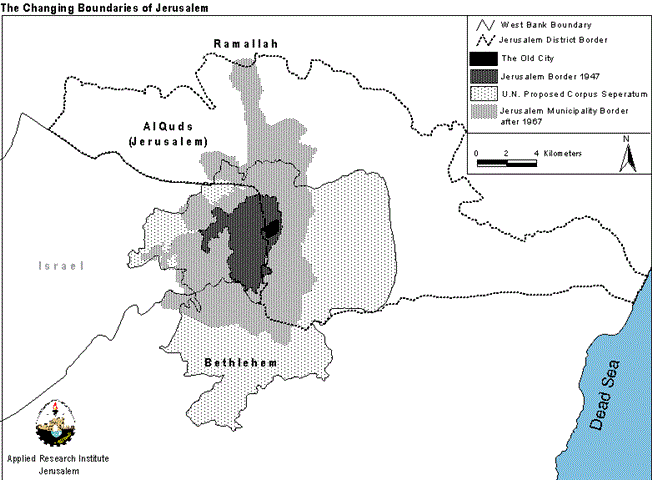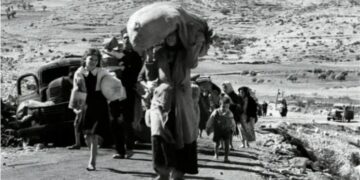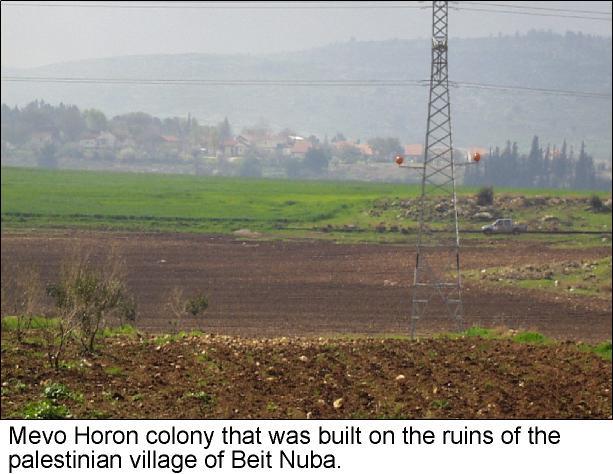Introduction
The many proposals put forward over the years for the solution of the Arab-Israeli conflict (with the Palestine question at its core) have all recognized the need to give special attention to Jerusalem. Numerous statements, documents, position papers and resolutions concerning the city and its special status have been made, but the question of Jerusalem is still an unresolved issue and a source of conflict.
''Jerusalem'' itself as a term came to mean different things to different people. There is Jerusalem the Old City, Jerusalem the modern city and Jerusalem the district. The boundaries of the city went through various transformations: The British mandate boundaries, the UN's Corpus Seperatum boundaries, and the 1967 Israeli boundaries (see map). Today Israel boasts that ''unified'' Jerusalem is its eternal capital. But practically, and due to many discriminative regulations, Jerusalem is not united and consists of two cities: West Jerusalem and occupied East Jerusalem. Moreover, by signing the Declaration of Principles on Interim Self-Government Arrangements (DOP) on September 1993, Israel and the PLO have made a commitment that ''the permanent status negotiations will commence as soon as possible… [And will] cover remaining Issues, including Jerusalem''. Despite this, and not withstanding its reiterated commitment to the DOP, the Israeli government's position is that Jerusalem will remain undivided under Israeli control, thus implying that there is nothing left to negotiate.
The first agenda item on the final status negotiations, which officially started in early September 1999, was Jerusalem. These negotiations were supposed to start in May 1996 and end by 1999. In the meantime, the Israeli government has not stopped its unilateral practices in Jerusalem by which it created de facto realities on the ground. These de facto realities are clearly prejudicing the outcome of negotiations on the final status of Jerusalem to Israel's favor. Such action is in total violation of United Nations' resolutions, particularly 298 and 242, as well as standing Palestinian-Israeli agreements.
Jerusalem before and after 1967
Jerusalem was an Arab city run by a Palestinian Muslim mayor from the seventh century to May 1948. However, from May 1948 to the present, the city of Jerusalem has endured a process of Israelization brought about by the dispossession and uprooting of its indigenous Arab Palestinian population and then by their replacement with Jewish immigrants. This displacement of Palestinians from the Holy City has been achieved largely in two stages:
-
The first stage occurred in May 1948 when the Zionist forces occupied all of what has come to be known as West Jerusalem, evicting by force its Palestinian inhabitants and physically taking over their lands, villages and homes.
-
The second stage took place after the 1967 war when Israel occupied East Jerusalem along with the rest of the West Bank.
Israel unilaterally changed the district boundaries in the West Bank by completely erasing the district of Jerusalem and including its respective parts to the Bethlehem and Ramallah districts, see map. Not only that, but Israel also expanded the boundaries of Jerusalem's municipality (unilaterally of course). The Kenesset formally annexed East Jerusalem in 1980 but the expansion of the municipal borders and colonization by confiscation of private Palestinian property started soon after the 1967 war (see map).
Procedures followed by Israeli governments to Israelize Jerusalem
1) Border Re-demarcation
Originally, and according to the 1947 UN Partition Plan, Jerusalem was supposed to be internationalized as a Corpus Seperatum; that means, a political entity under the UN's trusteeship and separate from both the proposed Arab and Jewish states. However, as a consequence of the 1948 war, West Jerusalem came under the control of Jewish forces and East Jerusalem ended up part of the Hashemite Kingdom of Jordan. Israel laid claim to the part of the city it controlled yet only a few countries recognized the sovereignty of Israel over West Jerusalem. This is the reason why countries that recognized Israel had their embassies in Tel Aviv and not in Jerusalem. In fact, the issue of moving the American Embassy to Jerusalem strains American-Israeli relations till this day.
As mentioned earlier, Israel expanded the borders of East Jerusalem from 6.5 km² to 70.5 km² to cover areas from Ramallah and Bethlehem. Those borders were drawn to include as much vacant land and as little Palestinian built up area as possible (see map). Today Israel is in complete control of the city, yet most of the property and real estate still legally belongs to the indigenous Palestinians who have been living continuously in Jerusalem for centuries. Israel's intensive development program after 1967 has involved the construction of housing and associated infrastructure in the unilaterally annexed and expanded territory of occupied East Jerusalem.
2) Demographic Balance
Having reduced the Arab presence in West Jerusalem to a minimum after the 1948 war, Israel was determined to follow up that process in East Jerusalem after the 1967 war. The official Israeli policy towards East Jerusalem dictated that a proportion of 78% Jewish to 22% Arab population should be maintained in the city (Ir Shalem, 1998). To that end, various policies were adopted (from tax policies, to budget allocations, registration procedures, etc) in an effort to achieve that proportion. Planning policies were no exception. According to a survey conducted by Ir Shalem, the results of those planning policies yield the following:
-
One third of East Jerusalem's 70.5km2 has been expropriated exclusively for Jewish neighborhoods.
-
Of the remaining two thirds, only 37.8% have approved plans.
-
About half of those with approved plans are designated as ''open spaces'' and thus construction is forbidden on them.
Hence, in the final analysis, we find that barely 7.3% of East Jerusalem is available for Palestinian residential construction.
The favoritism enjoyed by Jewish residents of the city becomes clearer when comparing East Jerusalem to West Jerusalem. The population density in East Jerusalem is 14.6 persons per dunum while in West Jerusalem it is 21.7 persons per dunum. Furthermore, building densities in East Jerusalem do not exceed the 50% margin while in West Jerusalem densities of 136% are reached.
Between 1967 and 1995 the Jewish population of the city had a 2 fold increase (from 197,700 to 417,000), while the Arab population had a 2.5 fold increase (from 68,600 to 174,400). Yet, the number of housing units in the Arab sector grew by 83% while the growth rate of housing units in the Jewish sector was 123% (Statistical Yearbook Of Jerusalem, 1996). Thus, since 1967, one housing unit has been added for every 3 additional Jewish residents of the city, while during the same period one housing unit has been added for each 9.7 additional Palestinian residents. Today, these numbers manifest themselves clearly in the characteristic overcrowdedness of the city's Arab neighborhoods. Indeed, Israel is going ahead with a clandestine campaign to squeeze the Palestinians out of Jerusalem.
Despite all that, the Israeli objective has not been met. Statistics show that the highest proportion of Jews in Jerusalem reached was 74.2% in 1967 and has declined ever since to reach 68.4% in 1998 (Statistical Yearbook Of Jerusalem, 1998).
Recently, the Israeli authorities announced that they would revise their policy of ID confiscation. This policy was one of many tactics used by the Israeli authorities to get rid of Jerusalem's Arab inhabitants. Thus, many Palestinian Jerusalemites were denied re-entry to Jerusalem when returning from travel or when residing in the West Bank. However, the plan backfired. Instead of driving out Jerusalem's Arab population, the plan rooted them in. The proportion of Arab residents has in fact increased from 25.8% to 31.6% (Statistical Yearbook Of Jerusalem, 1998). That's why Israel's reconsideration of the policy does not stem from a change in attitude towards Jerusalem's Arab population but rather from a need to ''reverse'' an ill-planned policy.
3) Encircling Jerusalem
In order to tighten its control over East Jerusalem, Israel is proceeding with plans to build new Israeli settlements and expand existing ones in and around the city. The range of these colonizing activities extends far beyond Israel's unilaterally declared borders of Jerusalem. Behind these activities lies the Israeli intention to stretch out the borders of Jerusalem Municipality and to envelop further lands of the West Bank into its domain. An examination of the Israeli colonizing activities in and around Jerusalem reveals the gradual application of the much talked about 'Greater Jerusalem' scheme (see map). Israeli activities in and around East Jerusalem indicate a systematic plan to achieve two broad objectives:
-
First, separating Jerusalem from the rest of the West Bank (at the same time separating the northern districts of the West Bank from the southern ones).
-
Second, strangulating Palestinian communities in East Jerusalem into vulnerable Arab islands in sea of Israeli settlements.
The assault on East Jerusalem is being achieved mainly by the outward expansion of settlements towards each other and the fervent construction of by-pass roads. The expansion of settlements end up forming huge barricades of Israeli built up areas from three sides (North, East, and South of Jerusalem) and the by-pass roads consolidate the expansions while cleaving Palestinian communities from each other. For an outline of individual cases of Israeli activities in East Jerusalem and their implication on the future of Jerusalem click here.
4) Other Colonizing Activities
Ever since Israel adopted the closure policy in 1991, Palestinians were required to have permits in order to pass through Jerusalem. To that end, numerous checkpoints were installed all around Jerusalem to impede the entry of Palestinians into the Holy City. This has been by far the greatest transgression on the rights of Palestinians. For, not only does it violate their basic right to Freedom of Worship, but it also severs the social communication between the Palestinian communities of the West Bank and those of Jerusalem thus isolating the Holy City from the West Bank (see map).
Israel's endeavor to make life difficult on the Palestinians does not stop at that however. Closing Jerusalem to the Palestinians has meant that Palestinians from the North and South could not travel freely to the other regions of the West Bank. Therefore, the only alternative left for them was the Wadi Al-Nar road that links Ramallah to Bethlehem. However, this road is twice as long as the road passing directly through Jerusalem (Wadi Al Nar is 47km long while the direct road through Jerusalem is 23km long) and consists of dangerous curves with steep slopes. So Palestinians commuting between North and South have to endure a long and dangerous journey at the time when passing directly through Jerusalem avoids this entire hassle. Again, this has led to the fragmentation of Palestinian institutions and firms in the North and the South and forced them to develop separately from each other. Furthermore, Israel forbids the Palestinian National Authority from having any offices or performing any official activity in East Jerusalem. Private Palestinian institutions too have suffered from Israeli restrictions and had to close their offices in the city to move to other cities in the West Bank.
As a result of all that, Ramallah ended up replacing Jerusalem as the center of Palestinian social, commercial, and cultural activity. Indeed, the primary goal of the Israeli authorities has been to erode the Arab character of the city; to ''De-Palestinize'' it.
Assessment and Recommendations
1. Jerusalem is subjected to a massive and accelerated Israelization process.
2. Palestinian areas in Jerusalem are being strangulated by Jewish settlements.
3. At present, there are more Jewish settlers in Jerusalem than in the whole West bank and Gaza.
4. Jerusalem is not a united city.
5. Since 1967, Israel has not allowed the construction of any new Palestinian neighborhood.
6. Palestinians alone cannot stop the Israelization process.
7. Palestinian efforts to combat the Israelization of Jerusalem, while being highly appreciated, can not substitute for the need of a concerted international action.
8. There should be no separation in the policy regarding the Jewish settlements in the West Bank and Gaza and those in Jerusalem.
9. There is complacency regarding Israeli violations in Jerusalem. Urgent actions is badly needed.
Proposed actions:
-
Worldwide campaign to assert Palestinian rights in Jerusalem.
-
Reinstate the central role of Jerusalem in spiritual, cultural, health and economic matters for Palestinians.
-
Reaffirm the position of the Orient House.
-
Promote Palestinian housing schemes in Jerusalem.
-
Support Palestinian Institutions in Jerusalem.
-
Defy Israel's policies and measures to isolate Jerusalem and prevent Palestinian's access to the city.
-
Emphasize Jerusalem as the capital of humankind.
-
Assert that without a just solution in Jerusalem, peace is unattainable.
-
Churches and Al-Awqaf should assume a major role.
-
Reaffirm the position of international bodies (such as the UN) that all Israeli unilateral actions are null and void.
Concluding Remarks
Israeli construction in East Jerusalem is altering the whole demographic and physical status of the city and strangulating the existing Palestinian neighborhoods, making it impossible for them to expand or absorb their natural population growth. Such measures are complimented with various laws that allow Israel to withhold the identification cards of over 60,000 Palestinian citizens in East Jerusalem and to deny them permits to live in the city. Demolition of Palestinian houses and denying building permits in East Jerusalem are other methods that Israel utilizes to evacuate the city of its Palestinian inhabitants. Israel has deliberately staged the delay in the final status negotiations on a peaceful settlement of the Israeli-Palestinian conflict in order to gain extra time that would allow it to create facts on the ground and consequently strengthen the Israeli position at the negotiation table.
Israel claims that it provides free access to worshipers and takes care of Jerusalem's religious sites. Yet, the issue of Jerusalem is not about shrines and historical sites but about the people that make them and the heritage that embodies them. Ever since its inception, Jerusalem has been the point where people converged from the east, the west, the desert and the sea. Newcomers blended into the mosaic of communities giving Jerusalem its ethereal character. Despite 30 years of relentless Israeli efforts to stifle that heritage and despite the vastness of Israeli resources if compared to those of Jerusalem's Palestinian population.. despite all that, the Palestinians held tight to their land as best they could in a desperate attempt to save the city's unique heritage. Jerusalem's history teaches us that those who refused to integrate and claimed exclusive right to the city where rejected by it no matter how long they stayed and no matter how limitless their resources might seem. Palestinian Jerusalimites are living proof of that spirit. Their attachment to the Holy City has rendered all Israeli schemes futile. As mentioned earlier, the few Palestinians that succeeded in remaining in the city have kept their proportion in spite of the influx of Jews and in spite of Israel's discriminatory policies against them. To the Palestinians, Jerusalem is Palestine and Palestine is Jerusalem. If peace is to survive in this region, then a just solution to the Jerusalem issue must be reached.
Acknowledgment
The author would like to acknowledge the efforts of the following people who participated in accomplishing this paper: Nizar Farsakh, Leonardo Hosh, Nezar Qattosh, Eyad Al-'Araj, Suhail Khalilieh, and Khalil Tafakji.
References
-
''East Jerusalem – The Current Planning Situation: A Survey of Municipal Plans and Planning Policy,'' Ir Shalem – Jerusalem, 1998.
-
Statistical Yearbook of Jerusalem, 1998.
-
Statistical Yearbook of Jerusalem, 1996.
-
Fr. Labib Kobti, ''Christians Stand For Justice In Jerusalem'', http://www.al-bushra.org Report On Israeli Settlement, Foundation for Middle East Peace (FMEP), www.fmep.org
-
Eye On Palestine, ''The Status Of Jerusalem Reconstructed – Israel's Unilateral Actions Determine The Future Of Jerusalem,'' www.arij.org
-
Eye On Palestine, ''Expanding the Jewish Presence in the Old City of Jerusalem'', www.arij.org
-
Applied Research Institute – Jerusalem (ARIJ) database and field verification
Prepared by:
The Applied Research Institute – Jerusalem
















